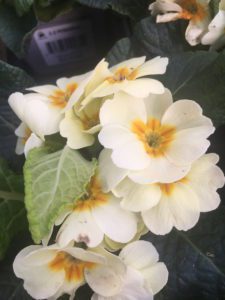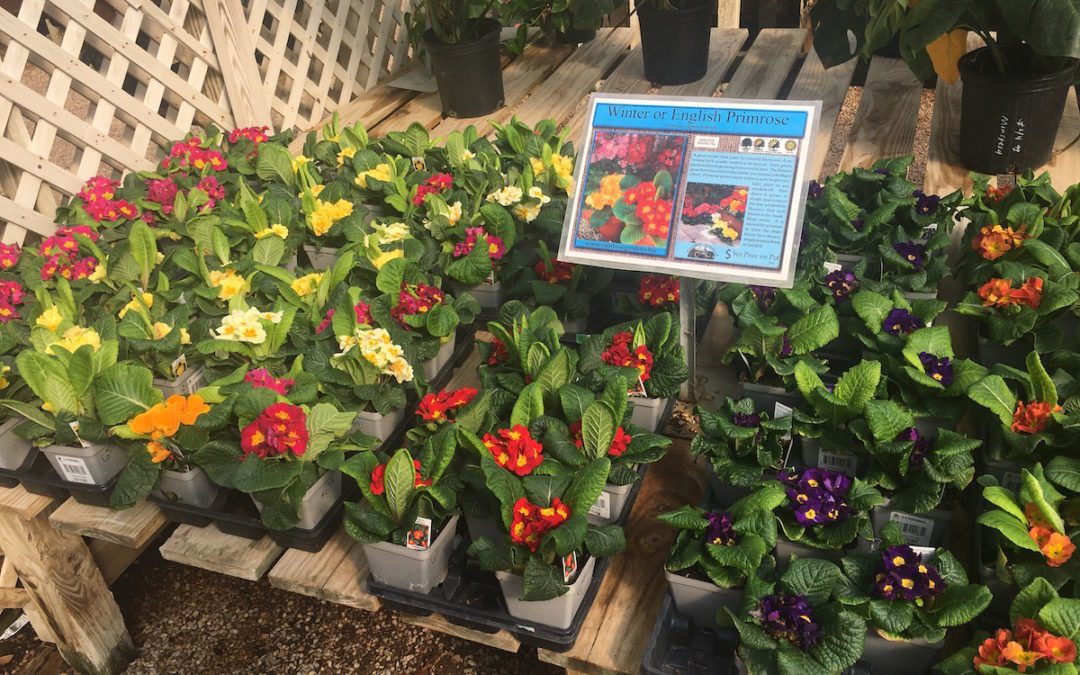Most of us scoop up a bunch of pansies to get our annual color fix throughout winter and there definitely isn’t anything wrong with that. But there’s another option for you. If brilliant color in a cold tolerant plant is what you crave, take a look at the primrose.
The primrose we are taking a look at today is also called Primula, (Primula polyanthus), This primrose is a fantastic winter bloomer. The intense color that these flowers put out can rival that of pansies and violas, which are more common winter choices. But unlike pansies and violas, which love all day sunshine, primrose require some shade, especially in the afternoon when the sun’s rays are the harshest. If you are in the market for an adorable, compact, colorful flower that will have no trouble standing up to cold temperatures*, we’ve got a good one for you today. Read on for more info and some growing tips.






Growing Primrose in San Antonio, Texas
Growing Habit: Besides the difference in light requirement, primrose is actually very similar to pansies in their stature and what they need to grow. Maxing out at height of only about 8” -12”, this compact plant grows in a clumping form. Dark green, textured, leaves are topped by clusters that contain anywhere from 4 -12 flowers that boast intense color. Their short stature makes them perfect choices for a spot front and center in your garden beds. They also look spectacular and perform just as well in containers.
- Plant 6”-12” apart and make sure that the crown of the plant is right at soil level when planted.
- Primrose can be divided in late winter/early spring if needed. Division only needs to happen if you find that you plant is becoming overgrown, or if you desire to propagate to have extra plants.
Light Requirement: As noted above, primrose must have protection from the sun’s rays when they are the strongest. Full sun in early spring or winter is a much different sun exposure than when summer begins to ramp up.
- High filtered shade, light shade, early morning sun and afternoon shade, are all suitable spots to house your primrose.






Water and Soil Requirement: Primrose like consistently moist soil. It is not advised to let them completely dry out between watering, however, soil should still drain well and not be allowed to get waterlogged and soggy.
- Choose a soil rich with organic matter that is slightly on the acidic side. A great planting mix would be FoxFarm’s Happy Frog with a little peat moss and sand mixed in.
- Applying mulch helps preserve water AND keep roots protected (warmer in winter, cooler in summer).
Cold Tolerance: While primrose are very cold tolerant (plant hardiness zone is 3a – 8b), it should be noted that if it gets cold for a long amount of time, they could go dormant. Flowers may freeze off during extended below freezing episodes. In our San Antonio climate, for the most part, primrose will stay evergreen and bloom happily through winter and into early spring.
- Plants will not bloom through summer and may show some decline, as they do not tolerate heat well. This is why some gardeners choose to treat this otherwise perennial as an annual in Texas.
(P.S. just for reference: Texas is also home to the wildflower primrose, also called Evening Primrose, which are different from the primrose discussed above. You’ve most likely seen the cheerful yellow or cotton-candy pink blooms of the wildflower primrose (Oenothera sp.) along our state highways.)
Don’t you think you can find a little shady spot for one or two of these beauties in your garden? Give yourself a little color in your life; I think you deserve it.
~The Happy Gardener, Lisa Mulroy


Is primrose deer resistant?
Winter primrose are considered deer resistant. Just remember that it always depends on the herd, drought conditions, and how hungry deer are if they will leave your plants alone. But in general, winter primrose tend to be left alone by deer.
2023/2024 I have one that bloomed all winter in South Jersey it’s been in the same pot for years outside but never bloomed in the winter until this year
Just bought some of these exact ones. Brought them back in when they broadcast 25 degrees. Now they’re hinting snow. . Should I bring them back in for safety sake? I just love them .
Hi Linda,
I always say when in doubt, bring them in if you can. They can tolerate some dips into the 20’s but it depends on how long the low temps are forecast for. If you love them, I bet you’d hate anything to happen to them, so bring them on in and enjoy them by a bright windowsill til Jack Frost passes by.
I’m going to plant more of these for winter delight
I love that they bloom in South Jersey in the winter
They are so vibrant. Enjoy the color!